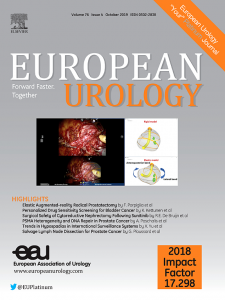Role of Retroperitoneal Lymph Node Dissection in Clinical Stage IIA/B Seminoma: Recommendations from the European Association of Urology Guidelines Panel on Testicular Cancer
IF 25.2
1区 医学
Q1 UROLOGY & NEPHROLOGY
引用次数: 0
Abstract
Section snippets
Background
Chemotherapy with three cycles of platinum, etoposide, and bleomycin (PEB) or four cycles of platinum and etoposide is the standard treatment option for clinical stage IIA/B seminoma, with relapse rates of 0–8% in clinical stage IIA and 8–14% in clinical stage IIB [1]. Historical use of radiation therapy with doses of 30 Gy for clinical stage IIA and 36 Gy for clinical stage IIB has resulted in relapse rates of 9–24% [1]. Despite low relapse rates and high cure rates, both treatment options areCritical issues for primary nerve-sparing RPLND
RPLND in early metastatic seminoma represents an oncologically effective treatment if performed at high-volume centers by surgeons experienced in testicular cancer surgery. Therefore, primary nerve-sparing RPLND (nsRPLND) needs to be concentrated in tertiary referral centers, as recommended in the European Association of Urology (EAU) guidelines [1]. The EAU guidelines panel is currently evaluating primary RPLND as a treatment option in early-stage metastatic seminoma, and the next update willConclusions
In summary, nsRPLND for marker-negative clinical stage IIA/B seminoma is associated with a low rate of treatment-associated morbidity and a chemotherapy-free survival rate of 80–85% if performed in expert hands. Both the American Urological Association and National Comprehensive Cancer Network guidelines include primary nsRPLND in their evidence-based recommendations for the management of low-volume clinical stage IIA/B seminomas [11,12]. The EAU guidelines panel is currently evaluating primary腹膜后淋巴结清扫在临床IIA/B期精原细胞瘤中的作用:来自欧洲泌尿外科协会睾丸癌指南小组的建议
背景:铂、依托泊苷和博来霉素(PEB)联合化疗3个周期或铂和依托泊苷联合化疗4个周期是临床IIA/B期精原细胞瘤的标准治疗方案,临床IIA期复发率为0-8%,临床IIB期复发率为8-14%。临床IIA期放疗剂量为30gy,临床IIB期放疗剂量为36gy的历史放疗导致复发率为9-24%。尽管复发率低,治愈率高,但对于早期转移性精原细胞瘤的原发性神经保留性RPLNDRPLND来说,这两种治疗方案都是关键问题,如果在高容量中心由具有睾丸癌手术经验的外科医生进行,则代表了一种肿瘤上有效的治疗方法。因此,原发性神经保留性RPLND (nsRPLND)需要集中在三级转诊中心,正如欧洲泌尿外科协会(EAU)指南bbb所建议的那样。EAU指南小组目前正在评估原发性RPLND作为早期转移性精原细胞瘤的治疗选择,下一次更新将得出结论总之,如果在专家的指导下进行,nsRPLND用于临床标记阴性的IIA/B期精原细胞瘤与治疗相关的低发病率和80-85%的无化疗生存率相关。美国泌尿学会和美国国家综合癌症网络指南都将原发性nsRPLND纳入了小体积临床IIA/B期精原细胞瘤治疗的循证建议中[11,12]。欧亚联盟准则小组目前正在评估初级
本文章由计算机程序翻译,如有差异,请以英文原文为准。
求助全文
约1分钟内获得全文
求助全文
来源期刊

European urology
医学-泌尿学与肾脏学
CiteScore
43.00
自引率
2.60%
发文量
1753
审稿时长
23 days
期刊介绍:
European Urology is a peer-reviewed journal that publishes original articles and reviews on a broad spectrum of urological issues. Covering topics such as oncology, impotence, infertility, pediatrics, lithiasis and endourology, the journal also highlights recent advances in techniques, instrumentation, surgery, and pediatric urology. This comprehensive approach provides readers with an in-depth guide to international developments in urology.
 求助内容:
求助内容: 应助结果提醒方式:
应助结果提醒方式:


